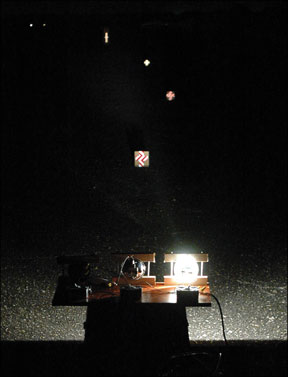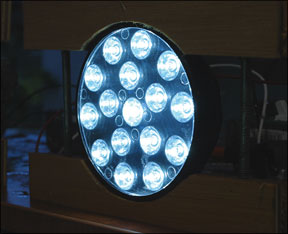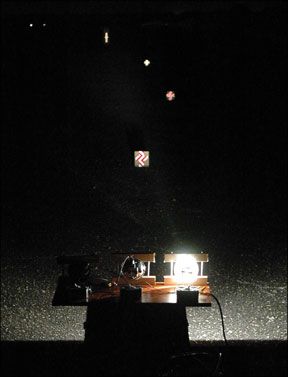Automotive technology trickles into aviation in fits and starts and with spotty success. HID lighting, for example, was practically standard equipment on some cars before it finally gained a foothold in the light aircraft GA market. Now LEDs-light emitting diodes-are undergoing a similar evolution.
Weve seen them in cars and on motorcycles for years and lately, theyve found their way onto wingtip and nav/position lights. Next step: landing lights. In this article, were examining a new product recently sent to us by a company called AeroLEDs. AeroLEDs is by no means the only supplier of this technology. Whelen,

for example, makes a line of LED landing lights and we know of some other similar products in development. we’ll do a detailed comparison of all the LED products in a future issue, but in this article, were interested in testing the concept itself.
Landing and taxi lights are big draws on the airplane electrical system for a reason: You need a bunch of light to reach through the murk to find night details necessary to establish depth perception and hazard detection. Although theyre inefficient in terms of converting electricity to light, conventional incandescent bulbs are still more than bright enough to do the job, which explains why theyve endured so long. At $20 a pop, theyre also relatively cheap, if not always reliable. Can LEDs hope to compare? We aimed to find out.
Why LEDs?
LEDs are one of those alluring technologies that seem too good to be true. They deliver bright, cool light with a fraction of the power required for an incandescent lamp. This, more than anything, explains why LEDs are turning up in everything from flashlights to automotive tail lights.
LEDs themselves have more to do with transistors than with traditional filament-type bulbs. LEDs have p-n or positive-negative semiconductor junctions, just like transistors do. When power is applied to the junction, electrons flow and drop into so-called electron holes-they actually revert to different orbits in the junction material. When that happens, energy in the form of photons is released. Physically, the p-n junction is small and so are LEDs. An individual LED is bright, but its overall light output is small, so to approach the requirements for something like a landing light or even a navigation light, multiple LEDs are ganged together. The SUNSpot product that AeroLEDs sent to us has 16 LEDs arranged in a circular lens assembly.
Unlike traditional filament bulbs, which concentrate their light energy from a single, bright filament and can thus use a single reflector, each individual LED has to have its own reflector assembly. This represents a challenge for the lamp designer and the largest problem is producing a coherent beam that will illuminate objects in the distance. In short, LEDs don’t do this very we’ll compared to single reflector lamps, in our view. In a gang design, they produce a locally bright beam thats wider and more diffuse than a traditional filament bulb, but they don’t reach out into the dark corners as well. This has pros and cons. The softer, wider beam is fine for taxiing or where you want to see the edges of a surface youre moving along. Its arguable whether this is better in the landing flare. To properly gauge height, you should be looking down the runway, not out the side windows at close-in objects. In reality, most of us probably use some combination of distant and close-in observation. But

if you want to reach far out into the darkness and produce sharp contrast to see a taxiway stripe or a sign, LEDs arent as good at that as a standard GE 4509 is. A typical 4509 landing light will render detail at greater distance than will an LED array. So will an HID.
Efficiency, Smarts
On the other hand, LEDs lead the league in efficiency. They require only about a quarter or less of the power consumed by a typical incandescent lamp and they run far cooler. In fact, we were hard pressed to measure much of a temperature rise in the SUNSpot after two minutes of operation. Theyre more durable than filament bulbs and are essentially lifetime lamps. (At $495, they ought to be.)
A 100-watt 4509 filament bulb has a nominal 25-hour operating life, although most get hammered by vibration and die before that. The Quartz Q4509 bulbs are a bit more expensive, but our tests show they last much longer. In fact, we burned one for more than 125 hours and it was still going strong. By comparison, AeroLEDs says the nominal life of its SUNSpot is 50,000 hours running at a current of about 2 to 3 amps.
In addition to efficiency, LEDs lend themselves to electronic control and AeroLEDs has taken advantage of this by attaching a smart circuit board behind the lens assembly of the SUNSpot. This board does a couple of things, one of which is to back the voltage off if the LEDs get too warm. Although they don’t make much heat, LEDs are still sensitive to it and theyll fry if allowed to get too warm.
The SUNSpot also has a built-in recognition light function in the lamp, which we think is a terrific idea. You can wire the lamp for steady-on or flashing operation. There’s an additional wire that can talk to another SUNSpot in a wig-wag flash pattern. In our view, a wig-wag is one of the most effective visual anti-collision lighting strategies.
Testing Them
To test the SUNSpot, we set it up in a test rack alongside two other bulbs, a standard Q4509 and a 35-watt HID system loaned to us by Knots2U, which makes one of our top-rated HID systems. All three were 12-volt bulbs and we powered them with both a charged battery and a vehicle charging system. To measure light output, we set up a measured course on a closed taxiway with reflective markers at 25-, 50-, 100- and 300-foot intervals. Using an ExTech lumens meter, we directly measured light output in lumens at various points along the test course, the results of which are shown in the chart at left. At each measurement point, we fished around for the brightest portion of the beam.
But raw light output is only part of the story, since its both the quality of the light, the color and the width of the beam that add up to perceived effectiveness of a landing light. Furthermore, whats good in a taxi light isn’t necessarily what youd want in a landing light or a recognition light.
During the tests, we also took some temperature measurements on the face of the landing light lenses. These were, pardon the pun, illuminating. No surprise that the incandescent bulb was the hottest. In a mere two minutes, it rose from 76 degrees F to a toasty 126 degrees F. The HID system doesnt get quite as warm-it made it to 104 degrees in two minutes-warm to the touch, but not blistering. The LED ran so cool that if you werent looking at it, it wouldve been impossible to tell if it was on. In two minutes, the temperature rise was a barely measureable 4 degrees F, confirming the intrinsic efficiency of LEDs.
While we were wiring things up, we connected the SUNSpots yellow wire to our power source and noted that it flashes at about a one-second rate, during which time it reaches full brightness, or at least full enough to be conspicuous. Although the beam is not as coherently focused as the other two lamps, it still seems to be quite visible at a distance.
Light Output
We werent surprised that the SUNSpots light output was the lowest of the three by a noticeable margin. It drops off dramatically at the longer distances needed to pick out detail a couple of hundred feet above the runway or to find a distant taxiway sign or stripe. (In its technical description of its products, AeroLEDs takes issue with this simple finding-more on that later.)
All three products produce a different quality of light. The Q4509s beam is hot, yellow and narrow and produces high, almost harsh contrast in objects it illuminates. Because of the narrowness of the beam, close-in objects such as taxiway edges are poorly illuminated. The HID has a similarly tight beam, but its a cooler blue and less contrasty. But its noticeably and measurably brighter. Of the three, it does distance illumination best, but has to be aimed carefully.
The LED is measurably the least bright of the three, but we were surprised at the quality of the light. While the HID practically torched the 300-foot target, the LED illuminated it minimally. But it was still visible and, moreover, because of the wider, diffuse beam, the LED lamp showed close-in detail better, including the taxiway edges. When viewed from down range and off axis, the LEDs wider arc appeared more bloblike than the other two, which we think makes it a better recognition light. The built-in-flasher improved this.
In the technical material on its Web site, AeroLEDs provides a candela map based on lumens data. The basic argument is that while the LED throws fewer lumens, it provides more uniform candela distribution. While we think our test confirmed this, what matters more is what the eye sees and interprets. Despite their sharply narrower beams, the Q4509 and HID provide just enough illumination close-in to provide depth perception for flare and distance estimation. We agree with AeroLEDs that the SUNSpot does this better, however. On the other hand, the SUNSpot gives up sharp distance illumination, which we would want for picking up the runway surface on short final and for seeing distant markers and hazards.
Conclusion
Frankly, given the brightness limitations of LEDs, the SUNSpot performed better than we thought it would, especially as a recognition light. We like the built-in circuitry to handle the pulsing. And while we think LEDs in general have promise, for a landing light, we still prefer the searing bright beam of the HID and would be willing to suffer an amp or two of additional draw to have it.
For the pilot who wants it all and has the budget, one of each wouldnt be a bad choice. If considering either a LED or an HID, one advantage of both worth weighing is that irrespective of brightness compared to an incandescent lamp, what youre also buying is the practical option of constant-on operation without worry of frequent replacement. We think this is a significant safety benefit for collision avoidance, not to mention not having to worry about changing bulbs. And speaking of changing bulbs, the SUNSpot is intended as a drop-in replacement for the standard 4509 bulb and will operate on 9 to 3 6 volts. (Roll your own 337.)
If youre sticking with cheaper 4509 bulbs, we recommend buying only the quartz version or Q4509. These are only a bit more expensive than the standard bulb, but they last longer and are little brighter.


